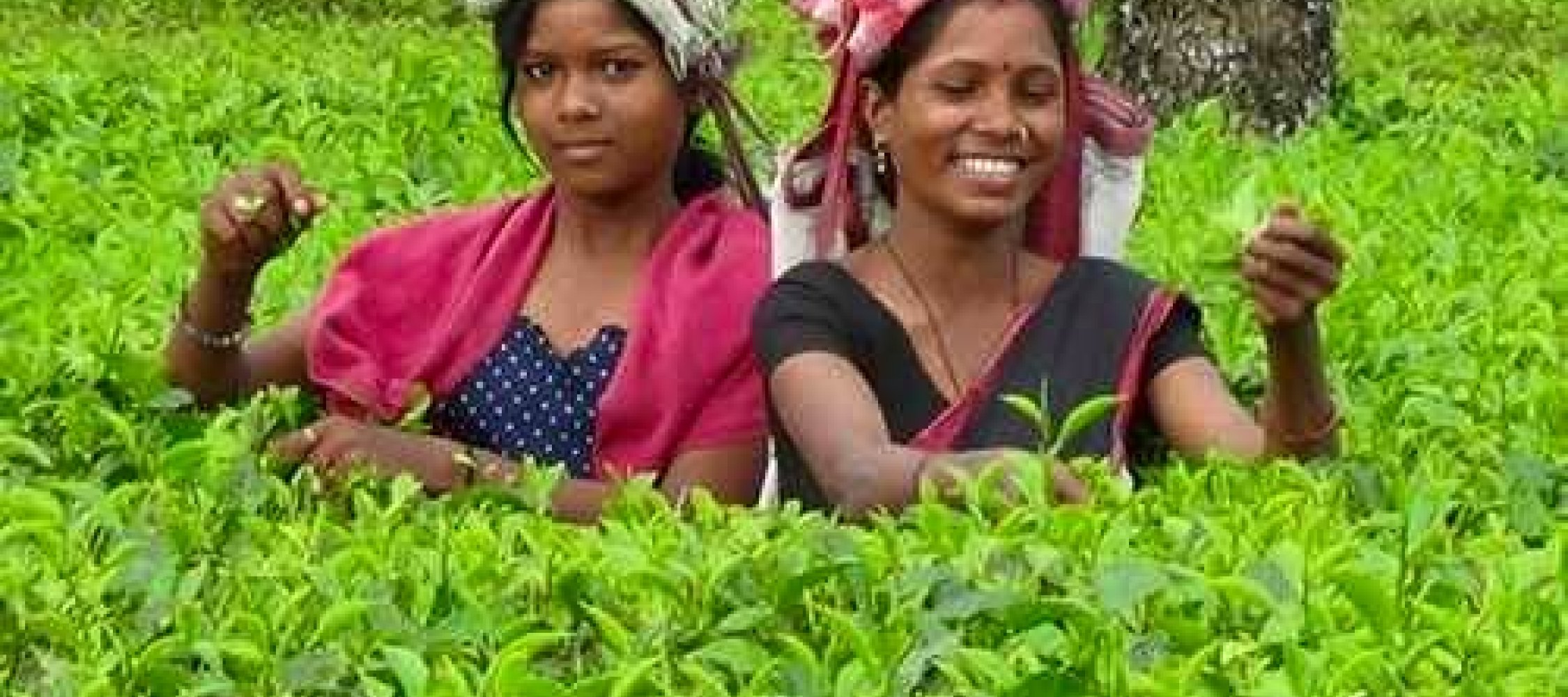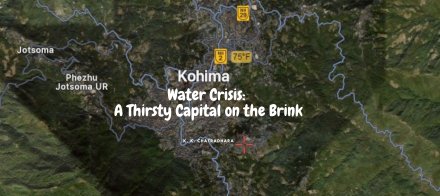 |
In one of our regular meetings, we ‘girl gang’ talked about the problems of the water delivery system in tea gardens of Assam, and the daily scramble for collecting water, especially by women! “But what is somewhat strange I find is that,” wondered my friend, “the same daily drudgery continues in most of the tea gardens!” Suddenly, the Borhat Tea Estate came to my mind, one of the older and bigger tea estates in eastern Assam. Why not find out what’s happening now there? I thought. I knew a person there, a retired babu of the Borhat Tea Estate and a family acquaintance.
“Kaka, tui asliyeineki? Hami paboiekhon (uncle, have you reached? I am about to get there),” I called Jaslal Kaka to make sure he was there. I was travelling in a passenger train from Tinsukia in the morning.
True to his word, kaka was waiting at the station to pick me up. The Borhat Tea Estate is about a kilometre from the station, so we decided to walk and talk along. Borhat is well connected by train from Tinsukia and Mariani; it’s about one and a half hour journey from Tinsukia on a passenger train, which costs just Rs.10 only.
The tea estate was set up in 1880 and was under the Borhat Tea Company’s ownership, kaka told me. Now, it is an Amalgamated Tea Plantation (earlier Tata Tea Limited) Company. Earlier, Borhat was in the undivided Sivasagar district. Years later, when Sivasagar was bifurcated, it became part of the newly formed district of Charaideo.
He briefly narrated a fascinating history of Borhat. Once there was a salt mine, about 10 km away from the garden at Nagapahar, then in undivided Assam, presently in Nagaland. The Arunachalis came down to this place via Jaypore Rainforest, extended up to Dillighat and partly to greater Borhat. Nagapahar is almost a tri-junction of Assam, Nagaland, and Arunachal Pradesh. The Nagas and Arunachalis came down on foot to collect salt from that mine. Every Sunday in the plains near a pond called ‘Rajapukhuri,’ they sold their salts. After selling their products, they would buy stuff from the local market, especially the tea leaves. Those highlanders used to halt for the night in private houses. They travelled back the next day. A thriving barter system was acceptable between the hill folks and the people of the plains. This exchange of goods and produces used to be done with the host families in whose houses they would spend the night.
Over the years, a weekly market came up there that catered to the growing demands of the local population. ‘Bor’ is the local word for ‘large,’ and ‘haat’ is for the market. That’s how it came to be known as Borhat. “The big Sunday market is no longer in that place; it has shifted near the railway station, and it has been there since then,” kaka said. The estate is 18 km away from Namrup, a small town that is an industrial hub too. The Hindustan Fertiliser Corporation, Assam Petrochemicals, and Thermal Power Plant of ASEB have their plants there.
“Borhat Tea Estate, here we are,” kaka announced. I looked up and saw the big signboard. I was so engrossed in his story that a kilometre of the walk was just like a happy stroll!
The famous historical road ‘Dhodar Ali’ goes through the estate, connecting Golaghat to Jaypore in Dibrugarh. The Ahom king, Gadadhar Singha, commissioned the construction of this road around the year 1687. It was named ‘Dhodar Ali’ because the king had employed dhods (‘dhod’ in Assamese means, ‘lazy’), and hired opium addicts for the road construction.
It was a lovely April morning, and it looked all green surrounding us. Birds were chirping all over. ‘What a serene place!’ I exclaimed. Kaka offered a pale smile. “It is all right on the surface,” he said.
“Oh, why! Is there anything wrong under the surface?” I couldn’t help myself asking.
“No, nothing new,” he muttered. “Time has flown by, but things have not changed as expected. Since the 1980s, people of this estate have been collecting water supplied by the garden authority twice daily – morning and evening – in a dirty water tank pulled by a tractor. Now, we are in the year 2020, but the same practice continues,” he sighed. “You will see how the crowd fights over water.”
“So it’s water you’re talking about,” I asked.
“Hon to (yes indeed)! What else did you think? At every step, we need water, and that is what we don’t have enough,” he rued.
We stopped at Darika Bania’s place, a well-known family in the locality. Darika Bania is no more. We met Tuscha Bania, his daughter-in-law. Tusha is around 60 years old. I asked her about the water situation here in the estate.
“My family used to fetch water from the single water tank provided by the garden authority each morning and evening. But after the retirement of my father-in-law, who was a Sardar in the garden, we were denied the supplied water,” she told us. The daily water supply is usually meant for the permanent workers’ families; they are entitled to get water first. Others can collect if some more water is left in the tank. “Nobody could imagine our plight at that period. They objected that none of our family members was any longer an employee of the garden, so we could not avail facilities of the garden, especially water, the life-sustaining gift of nature but in short supply, which was only for the employees,” she groaned.
“It must have been challenging for you!” I tried to console her.
“Hon to (yes indeed)!” She explained, “Bhogowanahe no (there’s God, you know).”
I looked at her eyes. She was willing to say more. So I wanted her to continue.
“I came here in 1979,” she began her story. “My father-in-law (Darika babu) was a Sardar of this garden. Generally, the females of the family would go to fetch water from the ‘water tank’.
“We had our tube well at my father’s house. We never had to go out for water. When I came here after my marriage, I experienced acute water scarcity from November to March. Of course, we had a ring well here, but it would dry up very early, say by the end of October, and after that, our misery would begin. So, you imagine a newly married woman standing in a queue for fetching water from a panitanki (water carrier)! It was a different experience! It was so embarrassing for me too. Anyhow, I got used to that. But the problem didn’t end there. I couldn’t keep the house clean and could not wash my utensils properly because of the acute water shortage. I couldn’t even keep myself clean, and water in the toilet was a daydream. At first, it was just unbearable for me. Gradually I learned to cope with this,” she took a short pause and then continued her sordid tale of water woes.
“Of late, my husband, Jagannath Bania, became a teacher. He managed to install a tube well in front of the house. We could have set it up in our backyard. But we thought others who needed water could have access to it too; after all, we were on the same boat. Now people come to our house to collect water,” she proudly said.
I noticed a group of students stopped by to get a mouthful of water from the tube well to quench their thirst. They looked happy and playful as they departed for their homes. We decided to take a quick tour of the tea estate. The systematically planted tall sirish trees (rain trees planted in the garden) added beauty to the sprawling green bushes, besides providing a shed to the tea plants.
An early monsoon shower filled the roadside nullahs (trenches) with water. A network of nullahs has been dug, dividing the whole tea garden into various small plots for proper drainage. Tea cultivation requires well-drained soil. We saw a few male workers carrying large drums on their backs; we were told that these were filled with insecticide. They were spraying insecticide over the newly sprouted tea leaves, and some of them who finished their jobs began to clean their drums with the water in the nullahs.
“That’s a bad practice – all toxic and harmful material will contaminate the water of nullahs!” I sounded an alarm. Kaka, too, joined me while expressing his concern.”Hinya ki khatirdhuchi? (Why are you washing here)?” he asked them in a tone of warning, “Jokhonmorbi, tokhongompabi! Naijaniaitabisslage (you may all die, don’t you know that it’s poison)?”
They laughed, looking at each other. “Dhule kononihobek. (Phu! nothing will happen),” one of them tried to downplay the alarm.
It was futile to argue with them, so we walked ahead. Kaka appeared truly upset, as he continued to mutter: “This insecticide will pollute the water and kill all aquatic life as well as harm animals, which may drink this contaminated water. “Moreover, during the monsoon, people go fishing in the nullahs and the paddy fields, located amidst the tea garden area,” he said.
Fishing, using all kinds of intricate indigenous traps, mostly made of bamboo and cane, is one of the favourite pastimes for all – men, women, and children – in the rainy season; nullahs get filled to the brim, and paddy fields are inundated. But now the quantity of catch is much less, we have learned.
As we walked by, we crossed a big pond. “This is a community pond in the garden and is the only source of drinking water,” kaka told me. It was possibly dug during the British period but is not adequately protected now. The pond was not fenced. “You can see this big water supply tower. The garden authority draws water from this pond and then supplies it through pipelines at certain roadside points – once early in the morning and evening. Besides, water is also delivered through water carriers daily to other locations where piped water is not available,” he said. “The water is not treated nor filtered, at least I haven’t seen. I have never seen this pond being ever cleaned in my 40 years service in the garden,” he lamented.
We entered Borhat Ali, a small path, and stopped in front of a house to chat with a man named Victor Dungdung, whose wife is a permanent employee of the garden. He was making a bamboo cage for the newborn chicks sitting in the courtyard of his house. The courtyard floor was polished with a fresh coat of red-brown soil. I felt the familiar scent of it. I saw a small group of women passing by, carrying botuwas (water pitchers) filled with water. They must have collected water from the nearby panitenki (water carrier) of the garden. A woman entered the house. She was wearing a rust-stained saree, which has turned almost red due to high iron content in water. Her pot was not covered with any lid. I noticed none of their pots had a lid. I wondered why they were carrying water without covering it! Victor laughed, “What will happen? They always bring water in this way,” he said.
Before I could respond, my attention got diverted towards a gust of loud laughter and cacophony of some yelling children. A few of them were blowing their noses, while some were scratching their body. All of them looked weak and frail, but they were cheerful and happy. Kaka perhaps understood what I was concerned about, “These children face different types of physical problems. Most of these are water-related and due to poor personal hygiene. Their parents don’t have time or enough water to keep them clean. Moreover, most families do not have easy access to safe and clean drinking water. They also lack awareness. It is only at schools that the children learn something about personal hygiene and the importance of covering cooked food and drinking water. At home, they are not accustomed to it. They have been brought up in this way,” he said while explaining why the living conditions and quality of life are so bad and alarming in the tea estate.
Meanwhile, we reached Alfred’s house, one of kaka’s best friends who he wanted me to meet. Alfred’s son works in the garden. Alfred’s wife Mariam was waiting for us. She showed us the way to the washroom. The small makeshift structure was erected with four bamboo pillars covered by a few jute bags, serving as four walls of the toilet cum washing space.
After washing, we sat on stools in the courtyard, arranged in front of the house under the shade of a tree. It was noon, and the sun was upon our head. She offered us some refreshment and tea, and while we were having tea, four women came in with botuwas to get water from the tube well. The water vessels had no lid.
Mariam spoke of ignorance and lack of awareness among women and people in general in the garden about sanitation and personal hygiene, including menstrual health. The water crisis made it worse, she said. “Sometimes we had to stay dirty,” she paused for a breath. “I saw working women facing more difficulties. They had to go to work even during their menstrual period. They cannot even take a break to change their clothes during the eight-hour workday. When they reach home, they may not have a proper wash of their body or clothes because of lack of water.”
“Don’t they use sanitary pads?” I interrupted.
She laughed aloud, “That is out of the question! Pads are not used even at present, and I am talking about the 1980s. Then, women used old, discarded clothes, and they still practice the same. Because most of them are not aware of its benefits, and besides, many cannot afford to buy the modern disposable sanitary pads.”
I am ashamed of myself, in 2020, and women do not know how to use or why to use a sanitary pad! “But why don’t you cover the drinking water? What about that?” I pressed for a response.
She admitted that illiteracy, lack of awareness, poor hygiene, and sanitation among people in the tea garden were the main reasons for the prevailing sickness and rampant diseases like cholera, diarrhea, dysentery and pneumonia. Mariam said untreated water delivered by the garden authority was one of the main problems. Even the water carriers used for supplying water to the workers are very old and seldom cleaned. Residents try their way to purify water for drinking purposes. They boil water with tea leaves and keep it for cooling, usually served as ‘normal drinking water. A pinch of salt is also added, she explained. “So, I think, education and public awareness is the only way to deal with these problems. It will take time, may be a lot of time, but I believe it will bring a change gradually,” Mariam smiled.
I looked at her eyes. It was glistening with hope.
About the story writer's:
Dr. Ranjita Bania is a Fisheries Biologist and Head of Aquaculture, Wetland and Livelihood Division of JEEVA SURAKSHA, Assam. She has done her Ph. D. from Dibrugarh University on “Hydrobiology and Fisheries of Dibru Saikhowa National Park”. Her area of interest is “river, wetland, climate change and livelihood development through aquaculture”. (ranjitabania@gmail.com, +91 96788 91071)
Ishani Gogoi is from Barpather Dighala Gaon, Dibrugarh. She did her post-graduation in English from Dibrugarh University. At present she has been working as graduate teacher at Santapur Chichapather High School, Bihpuriya in North Lakhimpur district.
Geolocation is 27.155157815107312, 95.31832662384173


